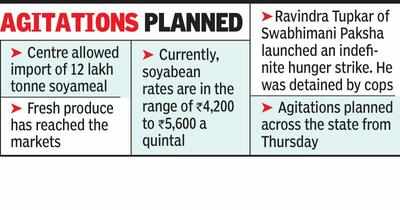- News
- City News
- nagpur News
- Soyabean rates crash: Farmers’ party launches protests over import policy
Soyabean rates crash: Farmers’ party launches protests over import policy

Nagpur: Swabhimani Paksha — the political party led by former MP and farm leader Raju Shetti — has raised demands to increase market rates of soyabean. Ravindra Tupkar, a party leader from Buldhana, began an indefinite hunger strike at Samvidhan Chowk in the city on Monday. Agitations are planned across the state from Thursday against the import policy that led to prices crashing recently.
In a late night development, cops detained Tupkar from the protest site.
Shetti says the centre’s move to allow import of 12 lakh tonne soyameal, used as poultry feed, led to the crash in soyabean rates even as fresh produce reached markets. This has ultimately helped corporates in edible oil business. The poultry industry, which has been demanding low rates of soyameal, is actually backed by corporates, he said. Shetti has also called for removal of GST on soyabean.
Just before arrival of fresh crop began in the market, soyabean was selling at Rs11,000 a quintal. This had built up farmers’ hopes, but the crash left the rates as low as Rs4,000 for some grades. TOI had reported the nod for imports.
Currently, soyabean rates are in the range of Rs4,200 to 5,600 a quintal. The MSP is Rs3,950 a quintal.
Shetti said from Thursday protests will be held at every tehsil in the state. The rates have improved since a week because of the stance by Swabhimani Paksha, he said.
Shetti’s party has demanded that centre should impose duty on imports, or stop imports completely. So far 6 lakh quintal of soyameal has reached India, and no further consignments should be allowed, he told TOI over phone.
Tupkar said apart from import duty even the stock limit on soyabean should be removed. This can ultimately take the rates to Rs8,000 a quintal.
Farmers incur a cost of Rs25,000 an acre for soyabean cultivation. The current rates are Rs4,100 a quintal. With an average yield of 4 acres, farmers are at a loss. The yield is low due to excessive rains, said Tupkar.
TOI also independently surveyed the situation. Market sources said when fresh arrivals started, the rates were in the range of Rs6,000 to 6,500 a quintal. There was a fall of Rs1,000 after that. Finally, it is in the range of Rs4,200 to 5,600 a quintal. Arrivals in the two major markets at Kalamna and Hinganghat are the same as last year. Some farmers also reported better crop.
Sources say even if the cost of cultivation does not go up to Rs25,000, yet the rate needs to be in the range of Rs7,000 to 8,000 for farmers to earn a decent profit. Under the current circumstances, the cost of cultivation is around Rs8,000 to 12,000 an acre.
Even cotton rates that had touched Rs8,700 a quintal are now in the range of Rs7,800 a quintal.
In a late night development, cops detained Tupkar from the protest site.
Shetti says the centre’s move to allow import of 12 lakh tonne soyameal, used as poultry feed, led to the crash in soyabean rates even as fresh produce reached markets. This has ultimately helped corporates in edible oil business. The poultry industry, which has been demanding low rates of soyameal, is actually backed by corporates, he said. Shetti has also called for removal of GST on soyabean.
Just before arrival of fresh crop began in the market, soyabean was selling at Rs11,000 a quintal. This had built up farmers’ hopes, but the crash left the rates as low as Rs4,000 for some grades. TOI had reported the nod for imports.
Currently, soyabean rates are in the range of Rs4,200 to 5,600 a quintal. The MSP is Rs3,950 a quintal.
Shetti said from Thursday protests will be held at every tehsil in the state. The rates have improved since a week because of the stance by Swabhimani Paksha, he said.
Shetti’s party has demanded that centre should impose duty on imports, or stop imports completely. So far 6 lakh quintal of soyameal has reached India, and no further consignments should be allowed, he told TOI over phone.
Tupkar said apart from import duty even the stock limit on soyabean should be removed. This can ultimately take the rates to Rs8,000 a quintal.
Farmers incur a cost of Rs25,000 an acre for soyabean cultivation. The current rates are Rs4,100 a quintal. With an average yield of 4 acres, farmers are at a loss. The yield is low due to excessive rains, said Tupkar.
TOI also independently surveyed the situation. Market sources said when fresh arrivals started, the rates were in the range of Rs6,000 to 6,500 a quintal. There was a fall of Rs1,000 after that. Finally, it is in the range of Rs4,200 to 5,600 a quintal. Arrivals in the two major markets at Kalamna and Hinganghat are the same as last year. Some farmers also reported better crop.
Sources say even if the cost of cultivation does not go up to Rs25,000, yet the rate needs to be in the range of Rs7,000 to 8,000 for farmers to earn a decent profit. Under the current circumstances, the cost of cultivation is around Rs8,000 to 12,000 an acre.
Even cotton rates that had touched Rs8,700 a quintal are now in the range of Rs7,800 a quintal.
FacebookTwitterLinkedinEMail
Start a Conversation
end of article
Quick Links
Delhi Air PollutionDelhi TemperatureChennai WeatherBangalore TemperatureCovid vaccination centres in DelhiCoronavirus in DelhiRTPCR test in GurgaonHyderabad RainPollution level in BangaloreDelhi SmogDelhi TemperatureNoida AQIGurgaon AQI todayFire in MumbaiMumbai RainsCovid 19 RT PCR Test in NoidaDelhi AQI todaySrinagar encounter

